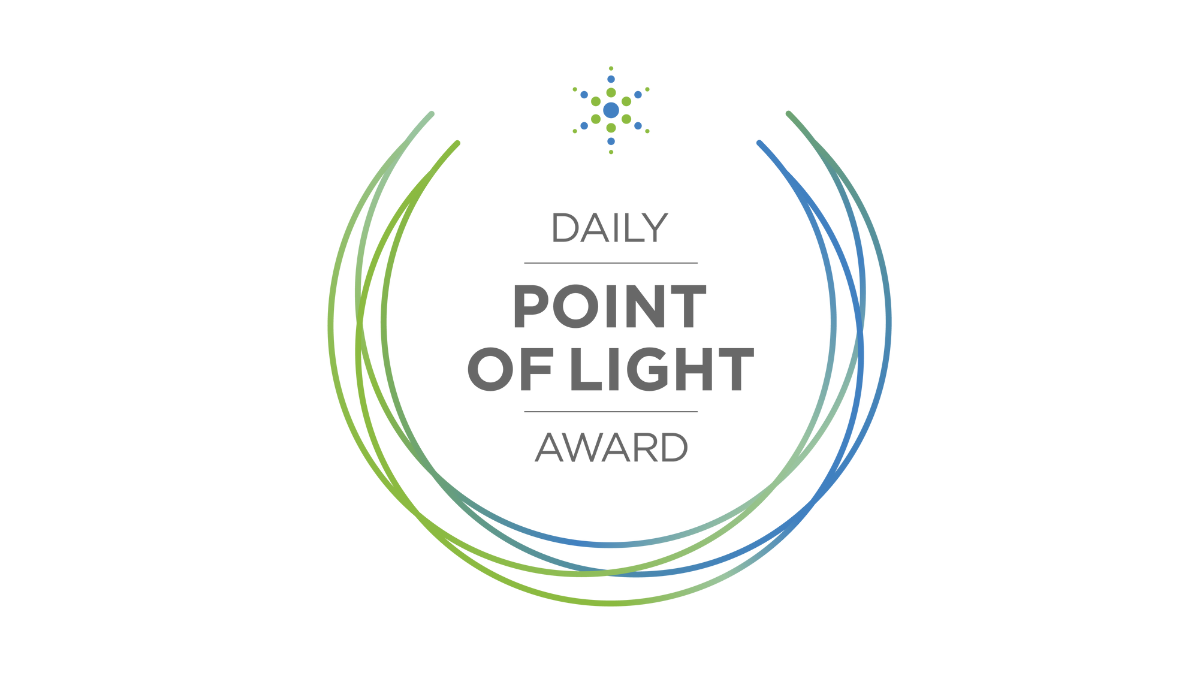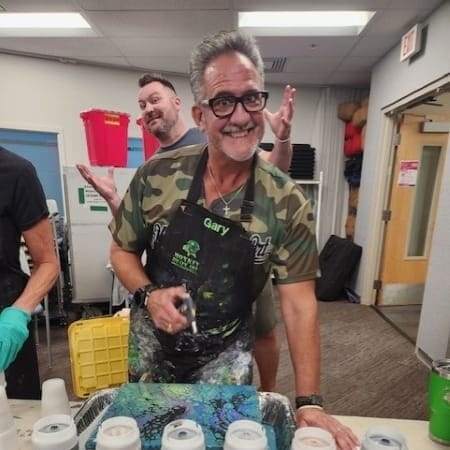Finding Calm Through Creativity: How One Veteran Is Healing with Art

Meet Daily Point of Light Award honoree Gary Walker. Read his story, and nominate an outstanding volunteer or family as a Daily Point of Light.
Gary Walker’s journey from military service to healing through art is one of resilience, innovation and deep commitment to helping fellow veterans and first responders. After serving for seven years in the U.S. Air Force and sustaining injuries during an undercover international drug operation, Gary faced the immense challenges of PTSD and traumatic brain injury (TBI). His struggles with mental health led his mother to encourage him to revisit an old passion—painting. What started as a personal coping mechanism soon evolved into a transformative program that now helps hundreds of veterans find peace through art, mindfulness and meditation with Monkey Brain Art.
As the executive director and lead instructor of the program, Gary has crafted a unique approach that blends artistic expression with therapeutic techniques to help those affected by PTSD regain a sense of calm. Over the past four years, he has worked tirelessly to provide these services at no cost to participants. More than 500 veterans, first responders, caregivers and nurses have completed the program, experiencing firsthand the mental clarity and relief that creative expression can bring. The overwhelming demand for his classes has led to a significant expansion, with additional offerings such as photography and wood burning, ensuring that more individuals can benefit from this innovative healing method.

Gary also plays a critical role in managing the nonprofit’s operations. He collaborates with the VA Medical Center to schedule class dates and secure spaces, recruits volunteers and students, and spearheads fundraising initiatives to sustain and grow the program. His dedication ensures that those who have served their country and communities receive the support they need to cope with the invisible wounds of trauma. His work has garnered immense positive feedback from participants, their families and the VA, further validating the program’s impact.
The success of Gary’s program is evident in the number of repeat attendees, many of whom find solace in the artistic process and return for additional classes. His work is not just about teaching art—it is about building a community of support, understanding and healing. With each brushstroke, photograph and wood-burned design, Gary is giving America’s warriors a way to process their emotions, calm their minds and rediscover hope.
What inspired you to get started with this initiative?
When I was 15 and in high school, I was really becoming a pretty good artist. I was winning blue ribbons and state titles. I thought, this is my path! My brother was an artist, so I thought it was in my DNA. Then at 16, I met my wife, Trish. Life changed dramatically. We decided at 16 that we wanted to get married. We got engaged at 17. To provide for us, I joined the military. I took from age 15 to 50 off from art.
I was injured in the military and medically retired at 25 years old. I’ve had 14 back surgeries and a hip replacement and a PTSD diagnosis. At this time, we had our son Zach. We started a janitorial company and I stuffed all my PTSD into that, into being incredibly busy all the time. We grew the business to 250 employees cleaning 147 buildings, and the stress had gotten so intense that it was starting to seep out everywhere. The doctor told me I was going to have a stroke. So after 25 years of being self-employed, Trish and I made the decision to sell the business.
Unfortunately, when Trish was on a business trip and we had an empty nest, the PTSD was raging. I was in a state of drinking, self-medicating and doing all the things you shouldn’t do. It was getting dark. My mom happened to call me, and she said, “Honey I know you’re struggling. Could you paint, like you did when you were 15?” I painted all the ugliness and darkness and everything else, for about 13 hours on my feet. And I slept for hours, like I hadn’t slept in years.
When Trish got home from her trip, I told her what happened and since she could see art was helping me out, she encouraged me to pursue it. Around that time, she got her yoga teacher certification, and she started teaching me yoga, mindfulness and meditation. After several months of that practice, I was starting to find my calm—which was painting abstract and listening to jazz. I escaped all that stuff that was going on in my head all the time. Fast forward, a friend loaned me some space and I could paint all I wanted.
Tell us about how the organization got its start.
We reached out to the program I went through for my PTSD, and said, “Listen, we have to share this. We can’t keep this to ourselves.” Trish and I felt like art, meditation and mindfulness was going to be a tremendous help to veterans, first responders, caregivers and nurses. That’s who we chose to approach because of the amount of trauma that occurs in those career fields. The program held a spot for us. Who starts nonprofits during pandemics? Trish and I did.
We had done an exhibit at The Battle Within, which was the veteran nonprofit that brought us under the wing. The VA happened to come to a meeting there and saw our exhibit. They asked about us, and they asked to meet us. When we met with them, they told us to send a wish list of what we needed to get the program off the ground. We did, and they did. They even found us a free space for our classes.
The reason we called it Monkey Brain Art was from the Buddhist teaching that an unsettled mind is a “monkey mind.” The first class had three veterans show up. But we kept pushing on. Slowly, veterans started to come and paint with us. It kept growing and growing. Now, here we are, four years later, and I just had class last night at a VA facility with 26 students. We have intro to art, photography and wood burning—which we just added this year. The way the class starts is that Trish will come in and do a mindfulness piece, and then she’ll do a three- to five-minute meditation. Then one of us veterans will lead the art class. Now, students tell me they need to meditate in order to paint.
To date we’ve had over 500 students go through our courses. It’s now become mostly through word of mouth. Other veterans and first responders are telling each other about the classes and courses. They’re showing up. It’s been a phenomenal experience. Trish and I now have a son, a daughter and two granddaughters. We’re getting to see people’s lives change.
What’s been the most rewarding part of your work?
It’s the clients, the students. Seeing people I worked with four years ago and how much they’ve grown. People from our program have ended up going to Kansas City Art Institute. Seeing people’s lives change. Seeing those “lightbulb moments.” We have a very diverse group of people – Vietnam veterans, veterans from Desert Storm. We’re veterans. We’ve walked in their shoes. We have PTSD. And we give them the toolbox. We give them ways to stop and breathe. We do tapping. We give them mantras. When we started four years ago, when I asked who had meditated that week, zero people raised their hands. Now, all the hands in the room go up.
And to think that the way this all started was trying to get myself better! Trish and I, high school sweethearts, are both going to be 60 this year. We’ve been married 41 years. We’re truly blessed with what we have.
Why is it important for others to get involved with causes they care about?
It truly is so important. It feeds your soul. It creates a legacy. Trish and I have always been philanthropic—we’ve raised over $1 million for Kansas City nonprofits. Taking that into the latter stages of our lives, I can’t imagine not doing something. There are so many rewards in it. I just had breakfast with a veteran who told me he’d been lost for 50 years. He had no transition coming back from war and we’ve helped him.
At our age, volunteering keeps us young. It gives us purpose. My dad retired and two years later, he was gone. We value the activity and connection of volunteering—you’re not lonely when you’re volunteering. There’s always someone to talk to and something to do.
Any advice for people who want to start volunteering?
Fortunately, a lot of corporations have groups within their business – doing a volunteer day. That’s a great place to start. I would always lean toward picking something I have a passion for. Explore your passion. The great thing about the internet is that you can search and find so many places and ways to get involved now. As a city, Kansas City is very philanthropic, so there’s a ton of opportunity there. Start to investigate what your passions are. You never know. You may start your own nonprofit.
Do you want to make a difference in your community like Gary? Find local volunteer opportunities.
